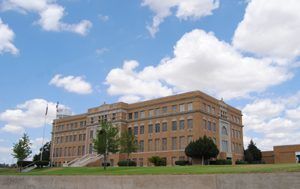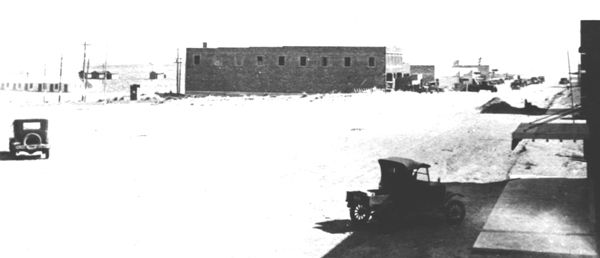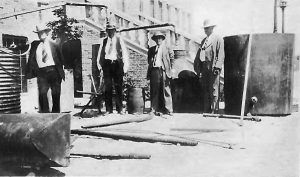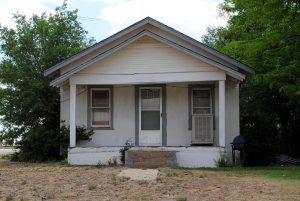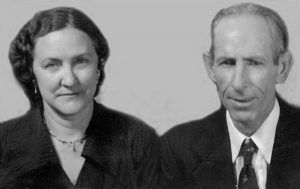The county seat of Hutchinson County, Stinnett got its start in 1925 when the Chicago, Rock Island, and Gulf Railway instructed Albert Sidney Stinnett and Joe Williams, two railroad men, to gain a right-of-way for a branch line from Amarillo, Texas to Liberal, Kansas. The site was selected because it was outside of the rough country along the Canadian River.
In July 1926, the railroad paid $48,000 to W.A. Starnes to secure the surface rights for that railroad line, and almost immediately, town promoters, Asa Phillip “Ace” Borger and J.T. Peyton formed the Stinnett Townsite Company and went to work developing a new town to serve as a railroad shipping point.
The land was then surveyed and platted, and it was named for Albert Sidney Stinnett, who was instrumental in choosing the site. The townsite was dedicated on August 11th, 1926. Just four days later, the Townsite Company declared a special “Dollar Day” event with a picnic and games, intending to sell lots. Hundreds of people gathered for the occasion. Within four months, $400,000 worth of lots were sold, with corner lots selling for as much as $1250 and inside lots as high as $1000.
The railroad company soon built a depot, the population quickly rose to almost 2,500 people, and numerous rough wooden shacks and canvas tents were hurriedly erected. In September, Ace Borger, sought to move the county seat from Plemons to Stinnett, and a petition was circulated among Hutchinson County residents. The petition was successful, and a special election was called for on September 18th, 1926. There were about 500 legal voters in the county at that time, and there were numerous “heated” discussions about moving the county seat. Obviously, those who lived in Plemons knew the consequences of what might happen to their town if they lost. They were right to worry. Plemons lost the election to Stinnett, and knowing how it would affect the town, Plemons residents threatened a court suit. The newly elected county commissioners responded by holding a midnight meeting and then backing a truck up to the Plemons courthouse, loading up all the county records, and driving off to Stinnett in the middle of the night. Though it wasn’t immediate, Plemons became a ghost town, and there is nothing but a cemetery left of it today.
Stinnett gained a post office on October 13, 1926, with Preston R. Walker as the first postmaster. Stinnett’s first courthouse cost $3000.00, but it was too small. Town promoter, Ace Borger, insisted that the best way to keep the county seat was to build an expensive courthouse, one that the people could not afford to move. In 1927, a bond election was carried which provided for the building of a courthouse at the cost of $450,000. That same year, the town was incorporated with a mayor-commission government. The new courthouse was dedicated on December 15, 1928, and continues to be one of the most beautiful courthouses in the state. The four-story brick and stone building was designed by Amarillo architect W. C. Townes and built by local contractor C. S. Lambie & Company. It features brick construction with cut-stone ornamentation, a 3-bay primary facade with a grand entry bay, raised basement with end entries, metal sash windows, and second-floor windows with round-arch stone lintels. Friezes at the east and west entrances of the courthouse depict the petroleum, farm and ranch, and cattle industries, historically the three principal commercial enterprises in the area. When it was originally built, the jail and sheriff’s quarters were on the top floor. These were utilized until 1982 until the courthouse was remodeled and a new jail was built. Located at 500 North Main Street, it was recorded as a Texas Historic Landmark in 1962 and on the National Register of Historic Places in 2012.
During Stinnett’s early days, the oil boom took place in Hutchinson County, and the town profited from the oil fields in neighboring communities and the railroad. Though the county seat was not a typical oil boomtown, filled with oil wells and roughnecks, it did have its share of lawlessness and violence. Many restaurants, rooming houses, and drugstores in town sold illegal whiskey and beer in their backrooms during the Prohibition era. One of its most notorious residents was John Waltine “Shine” Popejoy, known as the King of the Texas Bootleggers. He operated his illegal activities, which included prostitution from a bar in Stinnett called the Blue Moon. Popejoy was known to have robbed banks in Henrietta, Oklahoma, and Plemons and Stinnett, Texas. Under arrest and in the city jail in 1933, he was killed by a jailer after trying to escape.
When the Great Depression hit, the price of crude oil fell, resulting in Stinnett’s population dropping to just 500 and the number of its businesses being reduced from about 75 to fewer than twenty in 1930. Over the next decades, Stinnett grew once more from the development of natural gas and petroleum and, by 1960, reported a population of 2,695, eight churches, a school, a bank, a branch library, and a newspaper.
Although its boom days are long past, the community retained its importance as a commercial center for the surrounding grain-growing, oil, and ranching area. Today it is called home to about 1,900 people.
Stinnett is located in the central part of Hutchinson County at the junction of State highways 152 and 207.
© Kathy Weiser/Legends of America, updated April 2021.*
* Kathy is Ben and Irene Womble Foster’s granddaughter and the daughter of Wanda Foster Weiser, who grew up in Stinnett and attended the local schools. Kathy was born in Borger and spent her early years in Stinnett. At that time, her grandfather, Ben Foster, was the custodian/caretaker of the Hutchinson County Courthouse, and she, her siblings, and cousins were often known to run through the sprinklers on the courthouse lawn and create much noise and mayhem with wagons and running in the courthouse halls on the weekends.
More Information:
Also See:
Asa Borger – Father of a Wicked City
Borger “Rip Roaring” Booger Town
Hutchinson County – Panhandle Frontier
Sources:
City of Stinnett
History of Hutchinson County, Texas: 104 years, 1876-1980
Phillips High School Alumni Association
Texas Escapes
Texas State Historical Association
Wikipedia
Dedicated to Ben Merle Foster & Thava Irene Womble Foster
Thava Irene Womble Foster, most often called “Irene”, was the daughter of William Carson Womble, an early pioneer of Hutchinson County, Texas, who arrived in 1902. He operated a ranch/farm near Pringle and later moved to Stinnett.
Irene’s parents had 12 children, ten of whom they raised to adulthood in Hutchinson County, Texas. Thava Irene Womble Foster is Legends’ Founder/Writer, Kathy Weiser-Alexander’s grandmother. Kathy says “She was a major inspiration for Legends of America, as she was a lover of history, and introduced me to fascinating stories when I was a child. My mother and two aunts were Ben and Irene’s daughters, who grew up in Stinnett. I too spent my early years in Stinnett, Texas.”

